The HomePNA Alliance is an incorporated non-profit industry association of companies that develops and standardizes technology for home networking over the existing coaxial cables and telephone wiring within homes, so new wires do not need to be installed.
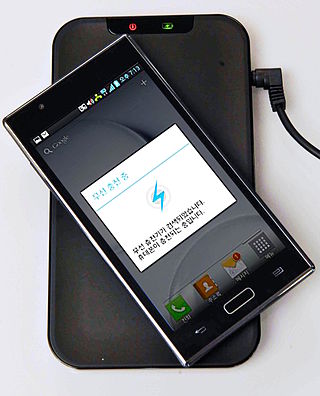
Wireless power transfer (WPT), wireless power transmission, wireless energy transmission (WET), or electromagnetic power transfer is the transmission of electrical energy without wires as a physical link. In a wireless power transmission system, an electrically powered transmitter device generates a time-varying electromagnetic field that transmits power across space to a receiver device; the receiver device extracts power from the field and supplies it to an electrical load. The technology of wireless power transmission can eliminate the use of the wires and batteries, thereby increasing the mobility, convenience, and safety of an electronic device for all users. Wireless power transfer is useful to power electrical devices where interconnecting wires are inconvenient, hazardous, or are not possible.
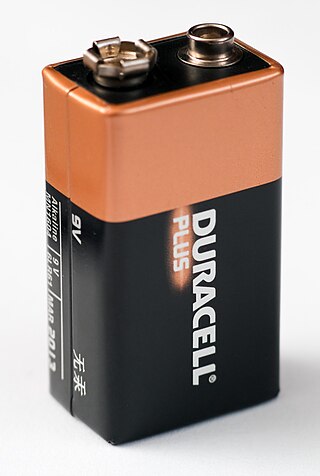
Duracell Inc. is an American manufacturer of alkaline batteries, specialty cells, and rechargeables; it is a wholly owned subsidiary of Berkshire Hathaway. The company has its origins in the 1920s, through the work of Samuel Ruben and Philip Mallory, and the formation of the P. R. Mallory Company.
OMA SpecWorks, previously the Open Mobile Alliance (OMA) is a standards organization which develops open, international technical standards for the mobile phone industry. It is a nonprofit Non-governmental organization (NGO), not a formal government-sponsored standards organization as is the International Telecommunication Union (ITU): a forum for industry stakeholders to agree on common specifications for products and services.
Digital Living Network Alliance (DLNA) is a set of interoperability standards for sharing home digital media among multimedia devices. It allows users to share or stream stored media files to various certified devices on the same network like PCs, smartphones, TV sets, game consoles, stereo systems, and NASs. DLNA incorporates several existing public standards, including Universal Plug and Play (UPnP) for media management and device discovery and control, wired and wireless networking standards, and widely used digital media formats.
The IEEE 1901 Standard, established in 2010, set the first worldwide benchmark for powerline communication tailored for uses like multimedia home networks, audio-video, and the smart grid. This standard underwent an amendment in IEEE 1901a-2019, introducing improvements to the HD-PLC physical layer (wavelet) for Internet of Things (IoT) applications. It was further updated in 2020, known as IEEE 1901-2020.
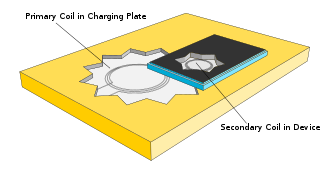
Inductive charging is a type of wireless power transfer. It uses electromagnetic induction to provide electricity to portable devices. Inductive charging is also used in vehicles, power tools, electric toothbrushes, and medical devices. The portable equipment can be placed near a charging station or inductive pad without needing to be precisely aligned or make electrical contact with a dock or plug.
TransferJet is a close proximity wireless transfer technology initially proposed by Sony and demonstrated publicly in early 2008. By touching two electronic devices, TransferJet allows high speed exchange of data. The concept of TransferJet consists of a touch-activated interface which can be applied for applications requiring high-speed data transfer between two devices in a peer-to-peer mode without the need for external physical connectors.
WiGig, alternatively known as 60 GHz Wi-Fi, refers to a set of 60 GHz wireless network protocols. It includes the current IEEE 802.11ad standard and also the IEEE 802.11ay standard.

The Alliance For Wireless Power is an industry standard group that uses the principles of magnetic resonance to develop a wireless energy transfer system over distance. The WiPower system uses directed and controlled magnetic fields to replace traditional power cords. To do this, the transmitter utilizes one or more primary windings in order to induce an even magnetic field above its surface. A receiver in the magnetic field uses a secondary winding which captures the magnetic energy and converts it back to electrical energy.

Resonant inductive coupling or magnetic phase synchronous coupling is a phenomenon with inductive coupling in which the coupling becomes stronger when the "secondary" (load-bearing) side of the loosely coupled coil resonates. A resonant transformer of this type is often used in analog circuitry as a bandpass filter. Resonant inductive coupling is also used in wireless power systems for portable computers, phones, and vehicles.
The Wireless Power Consortium (WPC) is a multinational technology consortium formed on December 17, 2008, and based in Piscataway, New Jersey. Its mission is to create and promote wide market adoption of its interface standards Qi, Ki Cordless Kitchen, and Qi Medium Power for inductive charging. It is an open membership of Asian, European, and American companies, working toward the global standardization of wireless charging technology.
DASH7 Alliance Protocol (D7A) is an open-source wireless sensor and actuator network protocol, which operates in the 433 MHz, 868 MHz and 915 MHz unlicensed ISM band/SRD band. DASH7 provides multi-year battery life, range of up to 2 km, low latency for connecting with moving things, a very small open-source protocol stack, AES 128-bit shared-key encryption support, and data transfer of up to 167 kbit/s. The DASH7 Alliance Protocol is the name of the technology promoted by the non-profit consortium called the DASH7 Alliance.
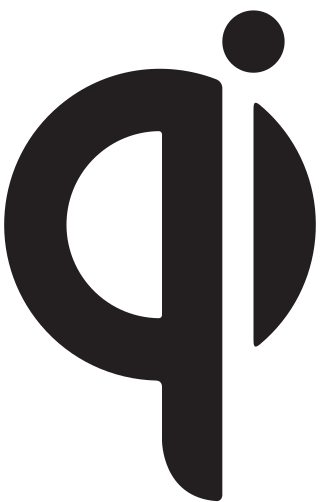
Qi is an interface standard for wireless power transfer using inductive charging. The standard allows compatible devices, such as smartphones, to charge their batteries when placed on a Qi charging pad, which can be effective over distances up to four cm (1.6 in).
Powermat Technologies Ltd. is a developer of wireless power solutions. The company licenses intellectual property (IP), selling charging spots to public venues along with the software to support their maintenance, management, and consumer interaction. The company's inductive charging technology has been adopted by the Power Matters Alliance (PMA) and is the platform adopted by Duracell, General Motors, Starbucks and AT&T.

Conductive charging is conductive power transfer that replaces the conductive wires between the charger and the charged device with conductive contacts. Charging infrastructure in the form of a board or rail delivers the power to a charging device equipped with an appropriate receiver, or pickup. When the infrastructure recognizes a valid receiver it powers on, and power is transferred.
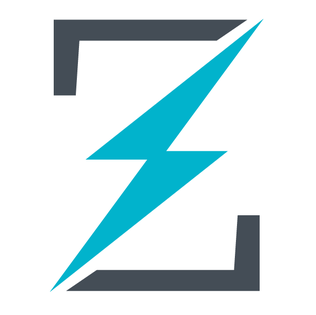
Rezence was an interface standard developed by the Alliance for Wireless Power (A4WP) for wireless electrical power transfer based on the principles of magnetic resonance. The Rezence system consisted of a single power transmitter unit (PTU) and one or more power receiver units (PRUs). The interface standard supported power transfer up to 50 watts, at distances up to 5 centimeters. The power transmission frequency is 6.78 MHz, and up to eight devices could be powered from a single PTU depending on transmitter and receiver geometry and power levels. A Bluetooth Low Energy link was defined in the A4WP system intended for control of power levels, identification of valid loads and protection of non-compliant devices.
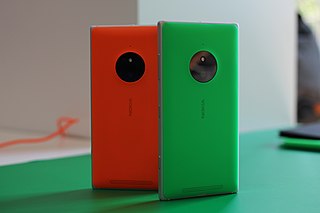
The Nokia Lumia 830 is a smartphone developed by Microsoft Mobile and branded as "Nokia" that runs Microsoft's Windows Phone 8.1 operating system. It was announced on September 4, 2014 at Internationale Funkausstellung Berlin and released in October 2014. It is a successor to the 2012 Nokia Lumia 820 and marketed as an "affordable flagship".
Ran Poliakine is an Israeli businessman, the founder and former CEO of Powermat Technologies. Poliakine is an entrepreneur, inventor and industrial designer.
SAE J2954 is a standard for wireless power transfer (WPT) for electric vehicles led by SAE International. It defines three classes of charging speed, WPT 1, 2 and 3, at a maximum of 3.7 kW, 7.7 kW and 11 kW, respectively. This makes it comparable to medium-speed wired charging standards like the common SAE J1772 system. A much more powerful WPT9 is being defined in J2954/2 for 500 kW charging for heavy-duty vehicles which have the room necessary to mount the larger induction plate.








